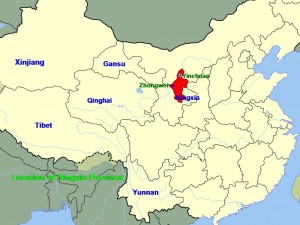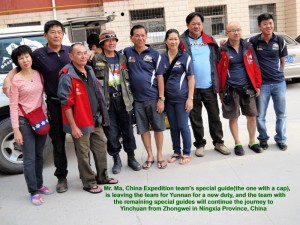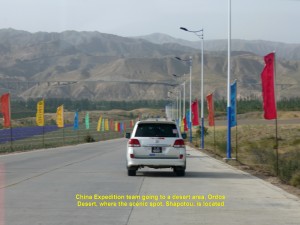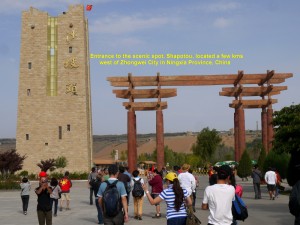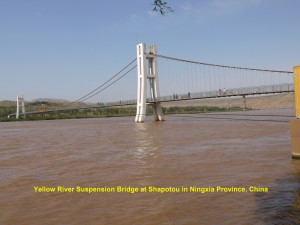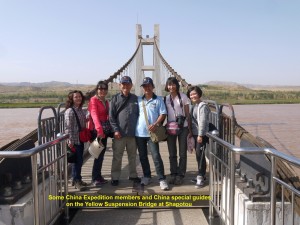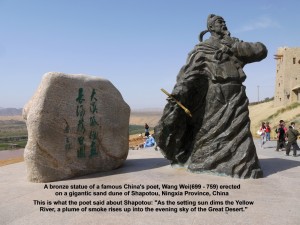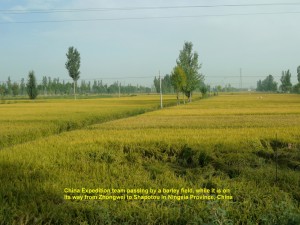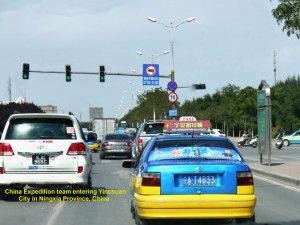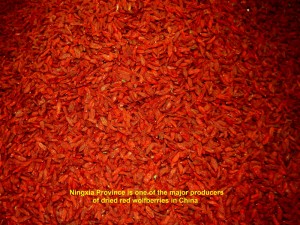Journal of My 2013 China Expedition Part VII (Ningxia)
Journal of My 2013 China Expedition Part VII (Ningxia)
Ningxia Province Journey
Day 29(Thursday, 12.9.2013)
Zhongwei – Yinchuan
Distance: 201 km
Before we began our journey from Zhongwei to Yinchuan, we bade farewell to Mr. Ma, one of our China’s special guides, who had helped us in our expedition for the past several days. He had to go back to Yunnan to take up a new duty.
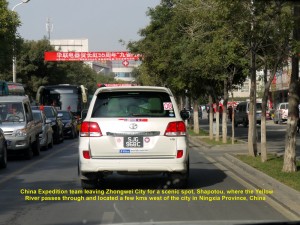
The China Expedition team leaving Zhongwei City for a Shapotou scenic spot located a few kms west of the city
At 9 a.m. we left Zhongwei City and headed westwards to a famous scenic spot known as Shapotou. Located a few kilometres from the city, Shapotou is a gigantic sand dune in the south-east of the Tengger Desert. It is 2000 m wide, 100 m high and inclines at an angle of 60 degrees. It slopes down to the S-shaped part of the Yellow River.
On arrival at the place, we bought tickets and entered the scenic area. As we were walking along the Yellow River, we saw a long suspended bridge for pedestrians spanning the river.
After walking for a few hundred metres, we reached a cable-chair station. Then we sat on cable-chairs and went to the top of the Shapotou’s large sand dune. When we reached the top, we walked to a vantage-spot where we were amazed to see an awesome panoramic view of the large sand dune sloping steeply down over 100 metres to a bend of the Yellow River, the curved river, trees and hills in the distance.
Erected at the viewing spot was a large bronze statue of a famous China’s poet during the Tang Dynasty. He was also a painter, musician and statesman. Wang Wei(699 – 759) was his name. He wrote what he saw one evening in the scenic Shapotou area:”As the setting sun dims the Yellow River, a plume of smoke rises up into the evening sky of the Great Desert.”
Walking back to the cable-chair terminal, we had three choices of going down to the bottom of the sand dune: cable-car ride again, zip-lining or sand-sliding. For me, I chose to go down by cable-chair ride as I wanted to record on my camera the breathtaking view of the Yellow River and its surrounding.
While we were walking back to the Shapotou entrance, we saw some of our fellow-members on rafts floating down the Yellow River. They had come down the sand dune by zip-lining and then went down the river by the rafts. Those rafts were unusual ones. Each one was made of a square wooden platform with over 25 air-filled goat skins tied to its underside, and could carry about 8 persons.
At 11.30 a.m. we left the Shapotou scenic area and travelled east to Yinchuan City which was about 200 kms away. We were travelling on a good expressway that crossed hot, arid land. Occasionally, we passed farmlands of barley, corns and wolfberries that were irrigated by water from oases and rivers.
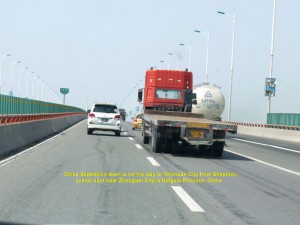
China Expedition team leaving the Shapotou scenic area near Zhongwei City for Yinchuan City in Ningxia Province, China
Three hours later, we, finally, reached Yinchuan City where we checked in at Sea Sky Grand Hotel. The Yinchuan City is the capital of Ningxia Province and has a population of about 2 millions.
Having checked in at the hotel, some of us were craving for western food which we had missed for many days. As we were walking down a road for a short while from the hotel, we were glad to find a KFC fried chicken outlet. We entered the eatery, ordered the food and ate with glee.

Some China Expedition members enjoying western food at a KFC outlet in Yinchuan City, Ningxia Province, China
Later, Cho Tat, my brother, and I strolled in the neighbourhood of the hotel. We came across a market where wholesale trade of many kinds of goods was carried out, actively. We stopped at a shop where we bought several kilograms of dried red wolfberries for our loved ones and friends back home in Malaysia. These dried fruits which are small are usually used in Chinese tonic soups. Ningxia Province is one of the major producers of these fruits in China.
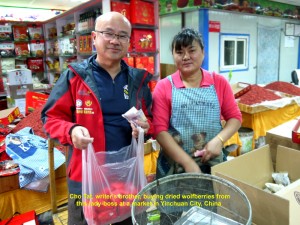
Writer’s brother(L), Cho Tat, buying dried red wolfberries at a wholesale market in Yinchuan City, Ningxia Province, China
Journal of My 2013 China Expedition:
Written by Choo Chaw, Kluang, Johor, Malaysia

